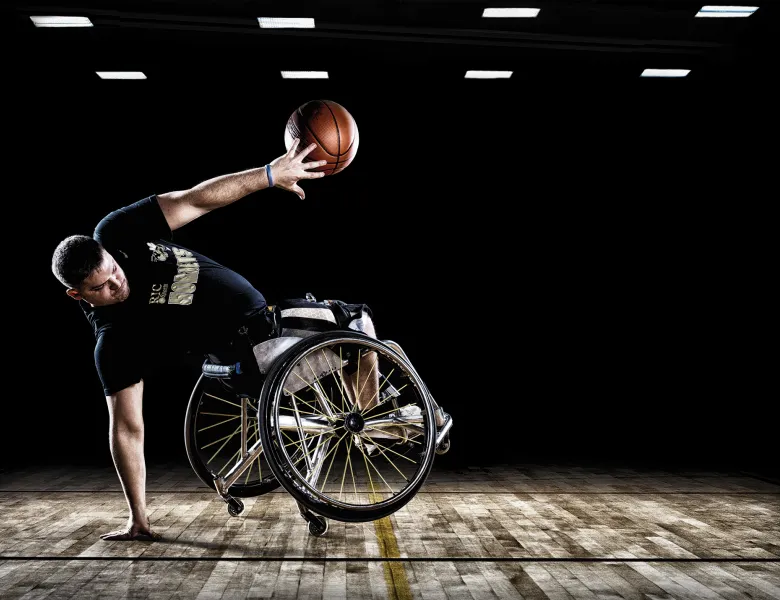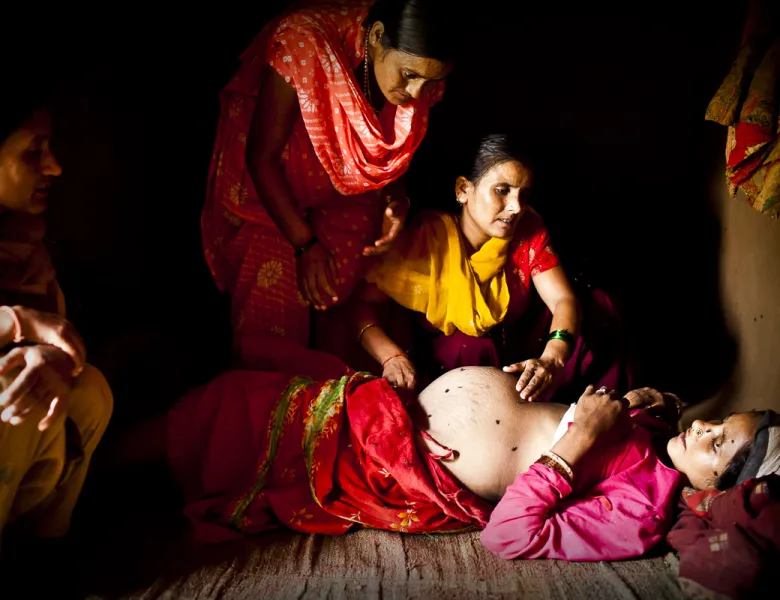Mum's Not The Word - Denise Felkin
Denise is shortlisted in the Professional People category of the 2016 Sony World Photography Awards.
Hi Denise. Tell us more about your series ‘Mum’s Not The Word’
‘Mum’s Not The Word’ debates the social stigmatisation of women, who by choice or circumstance, friction against the instinct of childbirth and maternal productivity.
I use the image of the unborn child brought together with the image of the nude bodies positioned in the fetal shape, in reverse. The project celebrates the female form and represents the division of women's experience between the fertile reproductive system and menopause.
It is very close to my heart. In my younger years I would tell my family and friends I did not want children. I was told I would feel different when older, I never did. The message is a subtle metamorphosis of a new attitude towards the female reproductive system and for some women childbearing not being a foundation of progress. The nucleus is representational of an intimate and introspective metaphysical investigation. The outcome reveals an unclothed woman in a posture that is easily read as relating to maternity and childbirth. This form remains singular as opposed to being reproduced. It is a posture that relates to the female as (none) reproducer and acts as a metaphor for the seed within. To personify the image, each subject is placed against the backdrop of her duvet cover adding a uniform approach to the images, when presented as a series. The subject is positioned upon the bed, a place of sexual activity, childbirth and a reverse space of contemplation. The position of the body is a symbol of a self-hug in an environment where there is pressure to breed. The Protective reflex of body language with head turned away or down is coupled with a pensive facial expression to represent the ending of maternity.
Maternal anarchy is an issue which continually makes an appearance in the media and awkward conversations, and is not represented visually. The outcome is a fusion of Frida Kahlo’s (none) maternal images against the backdrop of Tracey Emin’s bed.
The series is obviously highly personal in nature, but will speak to many about the choices we make as adults. What has the response been to the series so far
There are two categories childfree - women that don’t want children and childless - women who can’t have children. The childfree tend to be quite relaxed about the subject, whereas the childless are kind of grieving sometimes because of a choice they couldn’t make. I’ve had to be really sensitive in approaching women to come forward to be able to talk about choice and circumstance. We live in a world of expectations and childbearing is just not for some people. I don’t think such a stigma should exist for women without children.
My biggest challenge is finding more participants. One of my close friends who is also childfree refused to take part because she felt my approach made my subjects look vulnerable. Another friend said she would have wanted to be involved if she hadn’t fallen pregnant, accidently. Others I approached declined because of not wanting to reveal their bare bodies. Most women have consolidated being childless/childfree around menopause in their forties/fifties, a time in life where the body increases its aging process.
After a shoot a camaraderie of women sat merrily chatting on the mattress in my studio. It was such a relief, as never in my life had before had I been in a space where so many women were congratulating each about this subject. One of the ladies told me she great after doing the shoot, because it was an affirmation of her body being hers.
How did you come to photography? What does the medium mean to you?
My grandfather was a photographer. My father died when I was very young and my memory was too blurred to recall his face, because of this I spent a lot of time looking at our family photographs as a child. I often wonder, if I had not seen a photograph of my father, how my memory would have formed him?
I was a slow starter. My first camera was stolen at Butlin’s, when I was on holiday with my primary school. My second camera went missing when my friends car was broken into at Glastonbury festival, I was nineteen. My passion for photography sparked a few years later whilst studying an Art Foundation at Burton on Trent. My drawing skills were quite weak and the camera my aid to make my mark. I prefer the way photography (especially digital) gives immediate results. I’m obsessed with capturing light. If I’m not taking photos I’m thinking about constructing images. Like Walker Evans I’m a shy person, photography has enabled me to have a stronger voice, be bold and be heard.
Your work often includes captions, direct quotes & recorded interviews - why are these important to how you produce work?
I recently completed a Masters degree, at University of Westminster where the emphasis was on contemporary approaches to editorial and documentary photography. It was a critical understanding of images, as well as image and text relations. I’ve always been a fan of reading non-fiction. My work takes inspiration from the work of Jim Goldberg’s ‘Raised by Wolves’ captions where the subject speaks directly from beyond the image.
A few years ago I led a documentary photography project with homeless people about homelessness, using disposable cameras. As they took the photos, they wrote down their experiences, some were recorded in radio interviews. When it came to the editing and sequencing I collaborated with a couple of guys from the hostel I worked in. I didn’t change a word, because they weren’t my words to change. When the project was exhibited, my biggest achievement occurred whilst talking to the staff and service users of the homeless community. They responded to the images emotionally, with accurate and real information. If I change the words then the point does not come across, it’s then somebody else’s words ending up being fiction.
Do you have a photographic philosophy?
My instincts are keen to the moment and I want to make a photograph that looks painterly with a strong narrative. I research and plan my approach in advance, and collaborate with my subject at the shoot. I prefer to work with my subjects in their own environment in order for the visual codes to speak about their personae. In this scenario I shot in my studio where I asked them to bring along their duvet cover to personalise it. When I shoot I usually set up everything in advance, I then get my shot by waiting for the accidenta/unplanned to happen. I wait for that moment where the crease in a duvet, shift of a foot or soft focus can make the photograph.
What’s next for you?
I want to focus on ‘Mum’s Not The Word’ further, collaborate with women throughout the spectrum of nationalities, and ages; skin tones, body shapes. My aim is to document the attitude towards the negative position of the fetus within society today. I would like to broaden the dialogue and crowdfund a photobook to enable women without children to be seen in their community. I intend to unveil new and old dialogues and work closely with women to create images and curate the material to fuse art and documentary photography.
If anybody would like to be involved please contact me: [email protected].
denisefelkin.com







